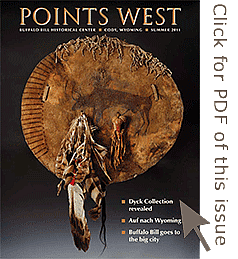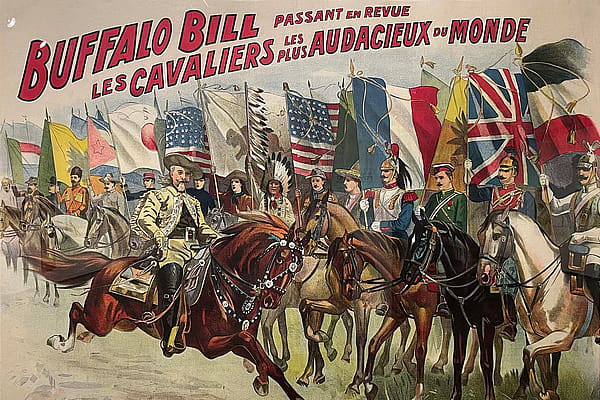Buffalo Bill Goes to the Big City, part one – Points West Online
Originally published in Points West magazine
Summer 2011
Buffalo Bill Goes to the Big City
Part One
By William F. “Buffalo Bill” Cody, 1916
Introduction by Dr. John Rumm, former Ernest J. Goppert Curator of Western American History
Beginning with The Life of Hon. William F. Cody, Known as Buffalo Bill, the Famous Hunter, Scout and Guide, published in 1879, at least half a dozen autobiographical accounts of William F. Cody’s life story appeared in print. The last one, “The Great West That Was: ‘Buffalo Bill’s Life Story,” was serialized in Hearst’s Magazine between August 1916 and July 1917.
Three years after Cody’s death, the stories were gathered together and published as An Autobiography of Buffalo Bill (1920) with illustrations by N.C. Wyeth. Scholars and historians have debated about the extent to which Cody himself actually “wrote” any of these various autobiographical accounts. Most agree, however, that he probably penned portions of the first and last ones, but whatever he did produce underwent heavy editing and revision before it appeared in print.
Within the William F. Cody Collection at the Buffalo Bill Center of the West’s McCracken Research Library is a typescript document of some two hundred pages that, until recently, has received little attention from researchers. In 2010, while conducting background research to develop the storyline for the “new” Buffalo Bill Museum—scheduled to open in May 2012—I happened on this document.
From what I could gather from my research, this was a stenographer’s transcript of Cody’s word-for-word dictation of his memoirs. He worked on the project during the winter of 1915 – 1916 while staying at the home of his niece, Anna Cody Goodman, in New Rochelle, New York.
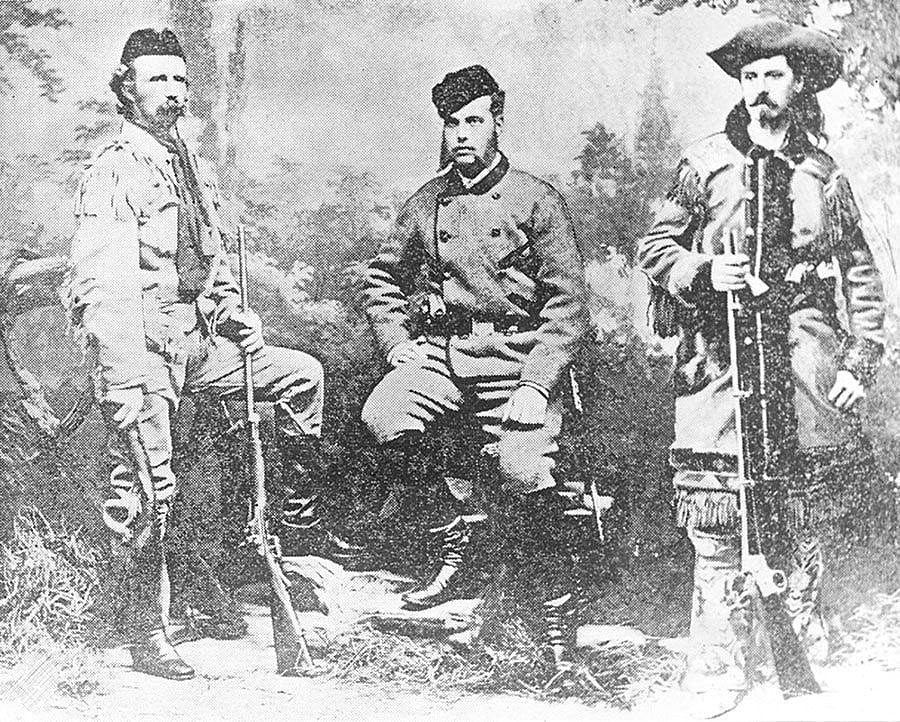
“For 14 days I haven’t left the house but twice and then to get shaved,” he wrote his distant cousin, J. Franklin Cody, in January 1916. “I have dictated 126,000 words, and my book of my Western life…is finished.”
Much of what Cody dictated was excised from the articles when they appeared in Hearst’s Magazine. Hastily typed and riddled with strikeouts, handwritten insertions, misspellings and run-on sentences, this remarkable and highly significant manuscript thus stands as the closest and most authentic representation of William F. Cody’s actual voice ever found. Unlike the heavily edited—even bowdlerized—published versions of his autobiographies, this raw and virtually unedited manuscript brings the “real” Cody to life as no other source does—colorful and profane, warts and all.
In this selection from his dictated narrative, Cody recounts how he received a much-coveted gift from the Grand Duke Alexis of Russia, a man whom he’d served as guide during a hunting trip in Kansas. The stint brought Cody national publicity and widespread acclaim, and led to an invitation to visit Chicago and New York. The rough-and-tumble man of the West who went east to the big cities was a far cry from the dapper and urbane man of the world who would make three trips to Europe as the impresario and star of Buffalo Bill’s Wild West.
• • •
During the hunt, the Grand Duke was wearing the finest overcoat that I had ever seen. It was constructed of many different kinds of Russian furs. Whenever the Duke would take it off, while he was shooting buffalo, I carried his overcoat on my horse, and when[ever] he finished his run and stopped, I would always get down and assist him in putting it on, and he couldn’t help but see that I admired that coat very much…
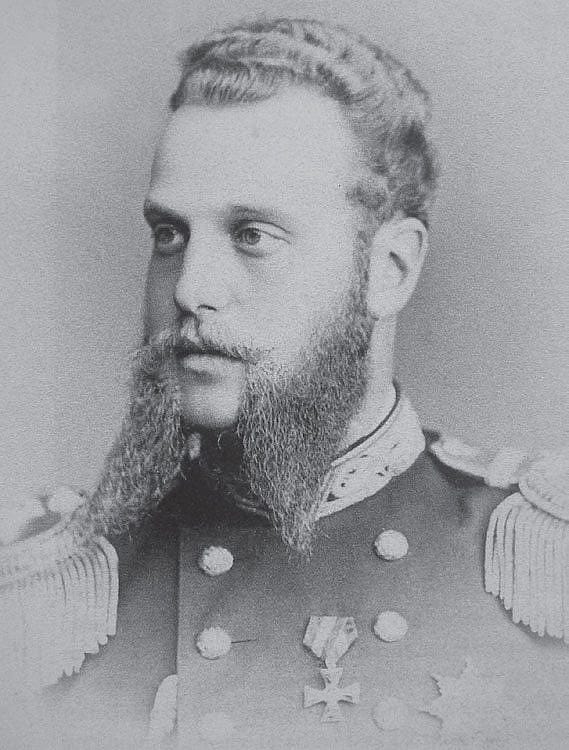
On arriving at North Platte, [Nebraska] the [Grand] Duke invited me into his car, and over a few bottles of champagne, we went all over the trip again. He said that it was an experience that he would never forget, that he had enjoyed every moment of it, and he thanked me for all of my valuable attention I had given to himself. I bade good-bye to him and also to General Sheridan, who was going to continue on to Denver with the Grand Duke, while I was to return to Fort McPherson, Nebraska.
As I was leaving the Grand Duke’s presence, some count—I cannot remember his name now—accompanied me and when we got to the door, he handed me quite a roll of green-backs. I told him that I couldn’t accept the money and thanked him very kindly. “Well,” he said, “here is something that you will accept, from his Highness,” and he presented me with a small beautiful box and also the overcoat which the Grand Duke had worn on the hunt…
[T]he count said to me,”His Highness wishes you to accept this coat.”
I asked him to please present my compliments to his Highness, and say to him that there was nothing that I admired more than I did that beautiful coat. I put the small box in my pocket and the coat on my arm. He returned to the Grand Duke and told him that I would not accept money, but I had accepted the presents—that, is, the little box—and also appreciated more than anything else, the coat.

The Duke asked General Sheridan who the best jeweler in America was, and Sheridan told him Tiffany [in] New York. He told the count to write to Tiffany, New York, what he wanted him to make for Buffalo Bill—a set of jewelry. It should be of buffalo heads, studded with rubies and diamonds—a large buffalo pin, representing a buffalo head, and shirt-cuff buttons, the same. They were to be made and sent to me as soon as finished. We had reporters along with us and they telegraphed this to their morning papers in New York, that the Grand Duke Alexis had commanded Tiffany & Company to build Buffalo Bill a set of jewelry, and shortly afterwards, when I went to New York, the New York papers came out with a statement that Buffalo Bill had come to New York to buy a shirt to wear his jewelry on…
A few days after this, General J.J. Reynolds, who had arrived at Fort McPherson with the third cavalry which had taken the place of the fifth cavalry that had been sent to Arizona, called me into the adjutant’s office and told me that he had a letter[,] railroad tickets and five hundred dollars in money for me, and also a thirty days leave of absence, whenever I wished it. These had been sent me [by] the gentlemen of the Millionaire hunting party that I had guided the summer before, which was known as the New York Millionaire Hunt, and they had invited me to visit them in New York. The general complimented me on my good luck and told me to let him know when I was ready to start so that he could date my leave of absence from the day I left the fort.
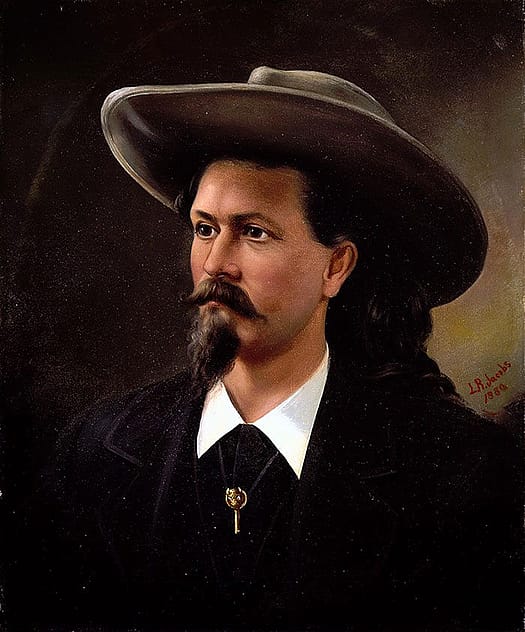
I immediately informed my wife and sisters that I would start for New York, as soon as I could get a suit of clothes built. Then I went up to the regimental tailor and selected a dark navy blue cloth for the suit, and I told him to start on it at once and finish it as quickly as possible. When it was finished I took it down home, and dressed up in it. I had bought a new necktie to wear [with] the present which was contained in the little box that the Count gave me, which proved to be a turquoise scarf pin surrounded with diamonds, and then I put on my overcoat and the new Stetson hat, and I considered [myself] the best dressed man in the United States. I didn’t have many other clothes to take along with me but I thought I would take one of my sister’s small trunks and put in some underclothes, and shirts, and I would also take with me my all-buckskin suit, as I said something may happen when I get to New York, whereby they might want me to dress up in my buckskins, for a masquerade ball.
I didn’t ask for my old pair of revolvers, and mother [Louisa] said, “Is it possible that you are going off on such a long trip without that old pair of guns of yours? You’ll be lost without them.” I told her that I hardly thought it was necessary to take them along, as I thought it wasn’t possible that I’d run into Indians on this trip, but she says “there might be some bad men in New York.” I told her if I found any there that the police could take care of them the same as the police in St. Louis. I went up and saw the general and I told him I was ready to go, and he gave me thirty day’s leave, and he also sent his orderly for the ambulance to take me over to the railroad station.
When the train arrived in Omaha, a lot of my friends heard that I was coming and they met me at the depot, and they drove me up to where the United States Judge, Dundee, was holding court. I had at several times taken Judge Dundee and my Omaha friends on hunts and when I walked into the courtroom and the judge seeing that it was me, rapped with his gavel, and said, “This court is adjourned so long as Cody is in town.” Then he came down off the bench and we all adjourned to the Paxton Hotel, where a banquet had been arranged in my honor. We had a jolly time there until the next train left for Chicago.
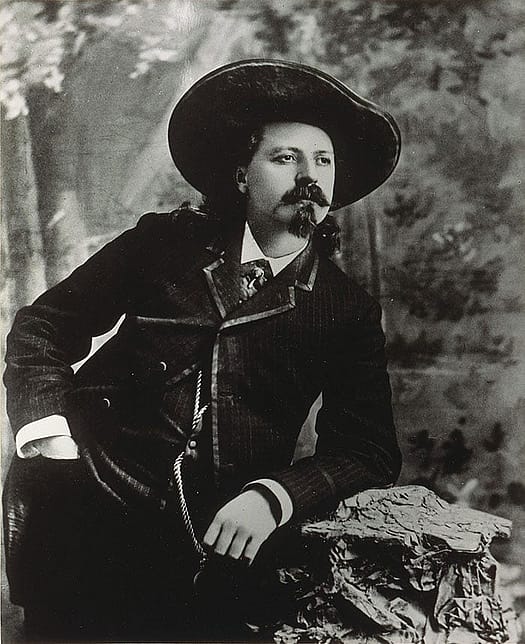
On arriving in Chicago, I was met at the depot, by Colonel W.S. Sheridan, General Phil Sheridan’s brother. He said, “Have you got any baggage with you?” I told him that I had got a trunk along although it did belong to my sister. He sent one of his men after the trunk and told him to check it up to the General’s house. The General and his brother “Mike” Sheridan were both bachelors at the time and they had a beautiful house on Michigan Avenue. Mike said, “Come along, get in the ambulance.” He told the driver to drive to headquarters. On arriving there Col. Sheridan took me into the Army Headquarters to meet the General. Passing through the Adjutant’s office, I shook hands with quite a number of the old officer[s] whom I had served with on the plains. I was still wearing that wonderful overcoat, that the Grand Duke Alexis had presented me with, and they all wanted to take a look at it. They said, “One thing [for] sure, Cody, you’ve got the best overcoat of anybody in America anyhow.”
By this time General Sheridan had sent word to show “Bill” in. I went to take off my overcoat before entering the General’s room, but Colonel Sheridan told me to keep it on, as the General wanted to see it. So Mike ushered me into the presence of the General. The General laughed and complimented me on the coat. He said, “I have looked at that coat several times on the [hunting] trip and if I had been a little bigger, I’d a made a play for that coat myself.” He told his brother, Mike, to take me on up to the House.
Read more about Buffalo Bill’s stay in Chicago in part two.
Post 053
Written By
Nancy McClure
Nancy now does Grants & Foundations Relations for the Center of the West's Development Department, but was formerly the Content Producer for the Center's Public Relations Department, where her work included writing and updating website content, publicizing events, copy editing, working with images, and producing the e-newsletter Western Wire. Her current job is seeking and applying for funding from government grants and private foundations. In her spare time, Nancy enjoys photography, reading, flower gardening, and playing the flute.
